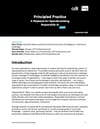⚡ Quick Summary
This CDT playbook translates years of scattered “RAI” wisdom into an actionable operating model any organization can adapt. Built from 2024 workshops and interviews, it sets out five foundations—the “5 Ps”: People (how to staff and structure), Priorities (what work RAI should own and how to triage it), Processes (governance mechanisms and checks-and-balances), Platforms (documentation, evals, monitoring, taxonomies), and Progress (metrics, maturity, and transparency). The report is pragmatic about politics: it names burnout, reorganizations, incentives, and performative stakeholder work as real blockers—and offers patterns to mitigate them (e.g., hub-and-spoke teams, intake forms, risk thresholds, internal “case law”). It’s not a one-size recipe; it’s a map of trade-offs so leaders can choose—and justify—their path.
🧩 What’s Covered
Origins & scope. The introduction frames the post-LLM governance gap and positions RAI as multidisciplinary work spanning legal, policy, UX, and engineering (title/authors on p.1; context pp.1–3). It grounds the playbook in 30+ practitioner inputs and secondary research, then surfaces the five “P” building blocks and their implications.
People: empower experts (pp.4–12).
- Hiring beyond “unicorns”; design for interdisciplinary collaboration; avoid structurally excluding non-CS talent.
- Team topology trade-offs: centralized vs. distributed vs. hub-and-spoke, and how proximity to revenue affects authority and independence.
- Engagement patterns: clear internal intake/review paths; regular external forums (advisory councils, co-design); beware tokenism and “performative” democracy.The section candidly addresses burnout, dissolutions, and the optics of shifting mandates.
Priorities: triage work (pp.13–18).
- Define RAI’s portfolio vis-à-vis compliance; anchor in regulation and human-rights norms without losing ethical scope.
- Triage criteria: severity, scale, regulatory traction, consumer-reported harms, societal impact, expert input.
- Create mechanisms so “important but not urgent” risks (e.g., subtle representational harms) don’t perpetually slip.
- Strategy: secure VP-level sponsorship, align mid-managers, and navigate culture with user stories, product roadmaps, and values.
Processes: structures for governance (pp.18–23).
- Standardize risk management (reference ISO/IEC 42001 & 23894), define tolerances early, and ground thresholds in evidence.
- Checks & balances: reporting lines to senior leadership/board, separation from comms, and adapting “Three Lines of Defense” to AI (first line product; second line risk; third line audit).
- Incentivize good behavior (launch gates, performance criteria, promotion paths) and blend formal rules with informal norms to avoid checkbox traps.
Platforms: responsibility infrastructure (pp.23–28).
Core plumbing: model inventories; shared evaluation tooling; off-the-shelf mitigations; post-deployment monitoring and feedback to vendors.
- Shared taxonomies & definitions (e.g., “fairness”, “transparency”) to prevent teams talking past each other and to enable prioritization.
- Implementation guidance via concrete decision schemas and an internal repository of “case law” (past decisions, trade-offs, thresholds).
- Documentation: start with a basic register, layer risk & decision artifacts, and design access/controls so legal constraints don’t freeze learning.
Progress: measure holistically (pp.29–33).
- Metrics that drive work without Goodharting; coverage-style goals to scale practices across teams.
- Maturity models (beginner → leading) spanning culture, structure, and methods—useful for planning and accountability, not as proof risks are solved.
- Transparent public communication: regular updates that inform (not market), support civic oversight, and avoid burden-shifting to end users.
Notable visuals/content: The title page (p.1) lists authors and affiliations; the “5 Ps” are introduced early (pp.2–3); the audit/Three-Lines framing is detailed around pp.21–22; documentation & repositories are emphasized on pp.27–28; maturity & transparency are consolidated on pp.29–33.
💡 Why it matters?
Most “AI principles” fail at the last mile. This playbook shows how to wire principles into org reality—budgets, launch gates, metrics, incentives, and cross-team rituals. It helps leaders right-size structures (central vs. distributed), avoid ethics-washing, and turn governance from a speed bump into a speed lane: once risk tolerances, tooling, and documentation are standardized, low-risk launches move faster—and high-risk work gets the scrutiny it deserves. For public bodies, the transparency and maturity guidance aligns with democratic accountability. For vendors and buyers, the inventories/monitoring guidance tightens feedback loops so issues are fixed upstream, not just patched downstream.
❓ What’s Missing
- Deeper “how-to” playbooks for sector-specific harms (e.g., healthcare triage, credit adjudication) and concrete eval recipes.
- Procurement templates and governance clauses for third-party models and agents.
- Quantitative exemplars of effective metrics (dashboards, target ranges) beyond general cautions about Goodhart’s Law.
- Change-management tooling (RAI OKR libraries, exemplar RACI charts, training curricula) to accelerate adoption.
👥 Best For
- Chief Privacy/AI/Risk Officers designing or refactoring AI governance programs.
- Product & Engineering leaders who need practical guardrails without shipping gridlock.
- Public-sector owners aiming for transparent oversight with evidence-based thresholds.
- Mid-market adopters who can’t hire a 30-person RAI team but want strong “minimum viable governance.”
📄 Source Details
- Title: Principled Practice: A Playbook for Operationalizing Responsible AI
- Authors: Beba Cibralic (Leverhulme CFI, Cambridge), Miranda Bogen (Director, CDT AI Governance Lab), Kevin Bankston (Senior Advisor, CDT AI Governance Lab), Ruchika Joshi (AI Governance Fellow, CDT)
- Publisher: Center for Democracy & Technology (CDT) – AI Governance Lab
- Date: September 2025 | Length: 34 pages | Type: Practitioner playbook / field guide
- Noted anchors: 5 Ps framework; ISO/IEC 42001/23894 touchpoints; Three Lines of Defense adaptation; documentation & maturity models emphasis.
📝 Thanks to
CDT’s AI Governance Lab and the practitioner community whose candid insights power this playbook; special credit to the named authors for synthesizing trade-offs practitioners can actually use.


